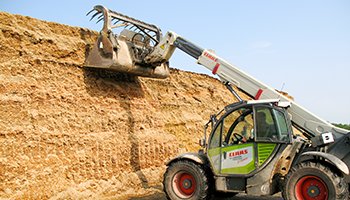Advantages of ultrasonic technology on biogas plants
Increase of biogas production
ULTRAWAVES ultrasonic systems are used in agricultural biogas plants to intensify anaerobic biological degradation of all kinds of added biomass materials, such as, renewable raw materials, maize, green waste, slurry, etc. This results in a wide range of applications for ultrasonic technology. Ultrasonic usually either enables an increase in biogas production with unchanged substrate supply or saves biomass added without losses in biogas production.
BIOSONATOR: High-performance ultrasonic for efficiency increase & energy generation in biogas plants
With integrated high-performance ultrasonic technology of the latest generation, the BIOSONATOR is an efficient and compact complete system for digesting biomass on biogas plants - even with difficult substrates. In order to now offer operators an even more practical and, above all, optimized solution, ULTRAWAVES, in cooperation with its colleagues from SONOTRONIC, has further developed the ultrasonic system into a plug & play system.
ULTRAWAVES guarantees at least 10 % increased economic benefit and accompanies customers from the beginning to success! You can count on more than 20 years of practical experience and more than 250 successfully implemented projects worldwide, as well as a reputable technology that is continuously being further developed.
Design and easy integration into biogas plants
The BIOSONATOR is our new complete system consisting of a modular high-power ultrasonic system, upstream wet macerator and an eccentric screw pump as well as an intelligent control and automation technology with remote maintenance. As a plug & play system, the BIOSONATOR can be quickly and easily integrated into existing biogas plants.
Usually it is sufficient to treat a partial volume of the fermenter or secondary fermenter contents with ultrasonic and return it to the fermentation process. This volume flow usually corresponds to 30 to 50 % of the daily fed substrate quantity. The standard ultrasonic system (connected load 5 kW) is very compact with a footprint of 1.45 m x 0.25 m and thus requires little space. On site, only inlet and outlet connections as well as a power and water connection are required. The ultrasonic systems themselves are usually in operation for 24 hours.
What are the advantages of using ultrasonic on biogas plants?
The production of biogas as a regenerative energy source is currently of great importance, which is why the number of agricultural biogas plants with fermentation of organic substrates (renewable raw materials, liquid manure, etc.) is steadily increasing. Ultrasonic plays an important role in overcoming the limitations of fermentation. Although fermenters on agricultural biogas plants are dimensioned with higher retention times, the rate-determining hydrolysis step must also be overcome here. For this purpose, sonication of the active bacterial biomass from the fermenter or secondary fermenter with ultrasonic has proven effective. This results in intensified anaerobic degradation with increased biogas production and, as a rule, also a higher methane content.
Which biogas plants are suitable?
- Biogas plants from 300 kW
With the new development of the BIOSONATOR, we have succeeded in reducing investment costs by 25 – 30%. The BIOSONATOR is thus also economically interesting for small biogas plants from 300 kW upwards. The amortization period is approx. 3 – 4 years.
- Renewable raw materials plants – also for alternative fibrous substrates
The technology is particularly suitable for biogas plants in which hard-to-digest, fibrous, and rough substrates (e.g. grass and manure) are fed. This makes them independent of easily fermentable substrates (e.g. maize).
- Co-digestion plants
In co-digestion plants, there is also a high potential for increased plant efficiency.
- Plants with dry substance up to max. 15 %
Hard cavitation is possible for the digestion of organic substances, which are difficult to degrade and have a dry matter content of maximum 15 %.
- Mesophilically or thermophilically driven plants
No matter whether a biogas plant is operated mesophilically (37 – 42 °C) or thermophilically (50 – 57 °C), in both cases our high-power ultrasonic technology can be used successfully.
- Plants that shift to alternative substrates
By replacing expensive substrates, more favorable substrates or residues from agriculture treated with ultrasonic, the substrate costs of the biogas plant can be significantly reduced.
Secure BAFA grant!
As the BIOSONATOR represents an investment measure for the energy and resource-oriented optimization of biogas plants, our customers can apply for a subsidy for the investment at the Federal Office of Economics and Export Control (BAFA). In the so-called BAFA module 4 – energy and resource-related optimization of plants and processes – a grant of up to 40 % of the investment costs for the BIOSONATOR can be approved. Including this BAFA subsidy, a payback period of usually less than two years is achieved. Further information on BAFA funding can be found on the following link, BAFA - Module 4: Energy and resource-related optimization of plants and processes. We are happy to advise and support you on this funding program.
Fermentation by ultrasonic
Technical limits of fermentation and their overcoming with ultrasonic
Anaerobic fermentation of organic substrate (biomass) is a mature technology. The biomass is decomposed by bacteria in the fermenter at temperatures of around 37 °C. The biogas produced is a metabolic product. This produces biogas as a metabolic product, the main component and actual energy carrier of which is methane. However, the anaerobic biodegradation process is very slow due to the solid biomass, which is difficult for bacteria to break down. The first step in the degradation chain is the so-called hydrolysis, which causes a reduction of the particle or molecule size and thus determines the speed of the entire degradation process.
Hydrolysis is where the action of our ultrasonic comes in. The ultrasonic vibrations act both on the structure of the substrates (disintegration of the cells) and on the active microorganisms (stimulation by alternating sound pressure and cavitation, prevention of agglomerate formation, release of enzymes). Biological hydrolysis is thus supported or completely substituted by the use of ultrasonic systems, resulting in accelerated and extended degradation.

Intensification of fermentation by ultrasonic
Ultrasonic intensifies fermentation in biogas plants. The fermenting microorganisms produce the enzymes (exoenzymes) needed to break down the organic matter. When our high-performance ultrasonic is applied, even a low energy input leads to increased release of these enzymes, so that the activity of the microorganisms is increased. Sonication also always leads to an increase in the interface between the liquid and solid phases (particles and flocs are broken down), which facilitates enzymatic attack.
Further energy supply also destroys walls of plant and bacterial cells and thus leads to the release of organic dissolved cell contents, which in turn are now very well degradable by fermentation. The end result is an intensified digestion process with further degradation of organic substrates and increased biogas production.
With the same biomass feeding, the use of ultrasonic can thus produce more biogas on the one hand, and on the other hand, the reduction of the feeding quantity is possible with unchanged biogas production. In addition, the quality of the biogas is improved by increasing the methane content. Due to the difficult degradable agricultural biomasses, the methane content on conventional biogas plants is sometimes below 50 %. In addition, sonication of the supplied volume flow reduces the viscosity of the fermenter contents, making them more flowable. This reduces the power consumption of agitators and pumps and consequently the power requirement of the biogas plant.
Areas of application and advantages
This innovative technology can be used in particular to treat fibrous and rough biomass suspensions (grass, manure, etc.) that are difficult to digest. The operator thus remains independent of the easily fermentable noble substrates (e.g. corn). Preferably, a recirculation stream from the secondary digester into the main digester is processed with the BIOSONATOR.
The biomass is broken down and increased microbiological activity is achieved in the fermenter. The result of the intensified process is a significantly increased biogas production (usually 10 to 15 %), which is offset by only a low energy input. The payback period of the investment is 3 to 5 years, which is correspondingly short. The connection of the container to the biogas plant is simple. There are connections for the supply and discharge of substrate and rinsing water on the outside. Only an electrical connection (400 V, 32 A, TN-S network) is required for operation.
Possible integration of the BIOSONATOR in biogas plants:

Equipment and technical layout
Inside the BIOSONATOR there are four units, arranged in the technological sequence:
- Macerator unit with spur gear motor (2.2 kW drive output)
- Modified eccentric screw pump with spur gear motor (1.5 kW drive output) and frequency converter
- High-power ultrasonic system (ULTRAWAVES / SONOTRONIC) with 5 kW connected load
- Volumetric flowmeter
Flow diagram of the BIOSONATOR:

Technical characteristics
- Flow system for continuous operation
- Reactor volumes of 20 to 50 l
(depending on the number of oscillating units and reactor chambers) - Number of oscillating units: 3 to 10
- Constant power output approx. 3 kW to 10 kW
- Frequency: 20 kHz
- Automatic amplitude control for amplitudes between 12 and 20 µm
- Intensity: 25 to 50 W/cm2
- Sonification time: 1 to 2 minutes
- Sonification dose: 2 to 5 kWh/m3
- Direct sonification of the biomass suspension, i.e. the oscillating units are immersed in the biomass suspension and generate so-called transient (“hard” = water vapor) cavitation as a result of the high amplitude, resulting in a rate of biomass breakdown which is around ten times that achieved by indirect sonification (oscillating unit fixed to a reactor wall) with comparable sonification doses.
References biogas plants
Advantages of intensification of anaerobic digestion and increase on biogas and waste fermentation plants
- Increase of energy production by 8 % to 19 %
- Reduction of oTR in digestate by up to 4 %
- Reduction of substrate costs by 5 % to 13 %.
- Increase in methane content by 1 % to 4 % and thus increased electricity production
Biogas plant Beerlage
- Germany
- 1.500 kW
- since 2016
Biogas plant Heinzhof
- Germany
- 720 kW
- since 2019
Biogas plant Hellweg
- Germany
- 500 kW
- since 2016
Biogas plant HKS Wittenburg
- Germany
- 716 kW
- since 2012
Biogas plant Hollmann
- Germany
- 500 kW
- since 2017
Biogas plant Koop
- Germany
- 590 kW
- since 2015
Biogas plant Lindow
- Germany
- 500 kW
- since 2008
Biogas plant Münster
- Germany
- 800 kW
- since 2019
Biogas plant Wesel
- Germany
- 500 kW
- Large-scale technical test 2007
Biogas plant Wulkow
- Germany
- 400 kW
- since 2015
What do our customers say after using our ultrasonic systems on their biogas plants?
“The substrate now comes out of the secondary fermenter like liquid water.”
Hartwig Koop, Koop Biogas Plant (Haren, Germany) July 2015
“With the BIOSONATOR, we have increased electricity generation in our biogas plant by 10 % for the same amount of substrate”.
Hans-Joachim Deter, Wulkow Biogas Plant (Neuruppin, Germany), 2017
Contact


